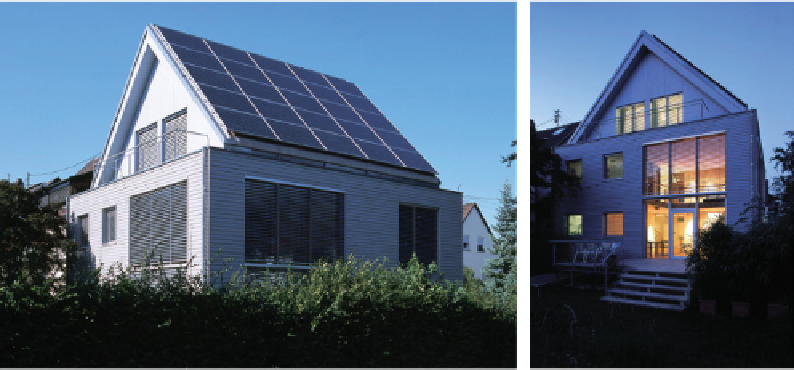Environmental Engineering Reference
In-Depth Information
The only other energy costs are those for normal electricity consumption. A green
energy supplier offers carbon-free electricity. The photovoltaic system saves even
more carbon dioxide than is emitted during wood pellet production and the transport
of the pellets. As a result, the energy supplied to this house is completely carbon
neutral.
14.1.2 Plus-Energy Solar House
If the entire roof of a house with optimal insulation is equipped with solar panels,
this can change a carbon-neutral house into a plus-energy solar house. An example
is the house shown in Figure 14.2. Optimal heat insulation using cellulose, triple-
glass solar glazing, a ventilation system with heat recovery and preheated air sup-
plied from the ground reduce the heat energy needs by about 80% compared to a
standard new - build.
Figure 14.2
Plus-energy solar house in Fellbach. The photovoltaic system feeds more energy into the
public grid each year than the house needs for its own heating and electricity.
Source: Reinhard Malz,
www.fellbach-solar.de.
A brine-water heat pump with 1.1 kilowatts of electric power covers the remaining
heat energy requirements of the house. The low temperature heat comes from two
vertical earth probes sunk 40 metres into the ground. A 0.50-kilowatt heat pump
would have been suffi cient but is not available on the market.
The photovoltaic system with a power output of 8 kilowatts peak feeds at least 8000
kilowatt hours into the public grid. The volume of energy exceeds the energy
requirement of the house, including the ventilation system and the heat pump. As
a result, the energy supplied in this house is not only carbon neutral but also saves
carbon dioxide in other areas due to the feed-in solar energy.

